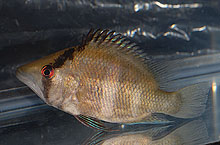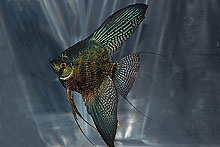Select date in side bar to go to a What's New of previous issues
| What's New
©by Laif DeMason
Now back from this year’s excellent ACA show in Louisville, I find it interesting to reflect on the many experiences there. One thing I am always amazed about is the sheer number of species bred by hobbyists. I must say I was impressed by the large number of Neotropical cichlids now being bred, from the rare and new species to actual locality morphs. Certainly a far cry from what was being kept in 1969 when I entered the hobby. If you cannot find something interesting or new to keep, go to a local fish show! Here’s “what’s new” on the cichlid scene: |
 The current interest in different goby cichlid forms have spurred collectors to not often collected areas. This photo is of the Eretmodus from Kekese, Tanzania north of Ikola. This fish exhibits the red hues sometimes found in Eretmodus found further north of the Bulu Point area. |
 Current exports from both Burundi and reportedly Zambia contain Neolamprologus savoryi. This fish was rather commonly exported in the 1980s from Burundi, but then fanciers seem to choose N. brichardi instead. The N. savoryi is a somewhat smaller and stockier fish. |
 Some of the lake’s mbuna are not usually caught for various reasons, either they are too aggressive, or too incidental to collect in numbers, or on remote reefs or other locations not usually harvested. Such a fish is Metriaclima zebra ‘Sunrise’ from Higga Reef. One of the jumbo-sized mbuna from there; females seem to sport a faint red dorsal not found in males. |
 Here is a fish long since forgotten! When the ‘Taiwan steveni’ was discovered in big numbers on the Tanzanian side of the lake in the early 1990s, there were actually two color forms. One color form was the Red Taiwan with a red anal fin, the other the Yellow Taiwan named for its yellow anal fin. The Red Taiwan became a more popular choice, and the Yellow Taiwan forgotten, until now, being re-exported from Mbamba Island again. (Photo by A. Konings) |
 The variety of Central and South American cichlids that people are breeding is astounding! One such fish is Caquetaia myersi, an odd-ball predator from the Amazonia area of Colombia. This fish’s unique shape and protrusible mouth must be appealing to any cichlid fan. |
 The freshwater angelfish, Pterophyllum scalare is one of the first cichlids kept by many hobbyists. Over the years some incredible color varieties have be selected by breeders. Pictured here is a beautiful blue zebra, veiltail strain that will surely be a show-stopper. You’ve come a long way baby! |